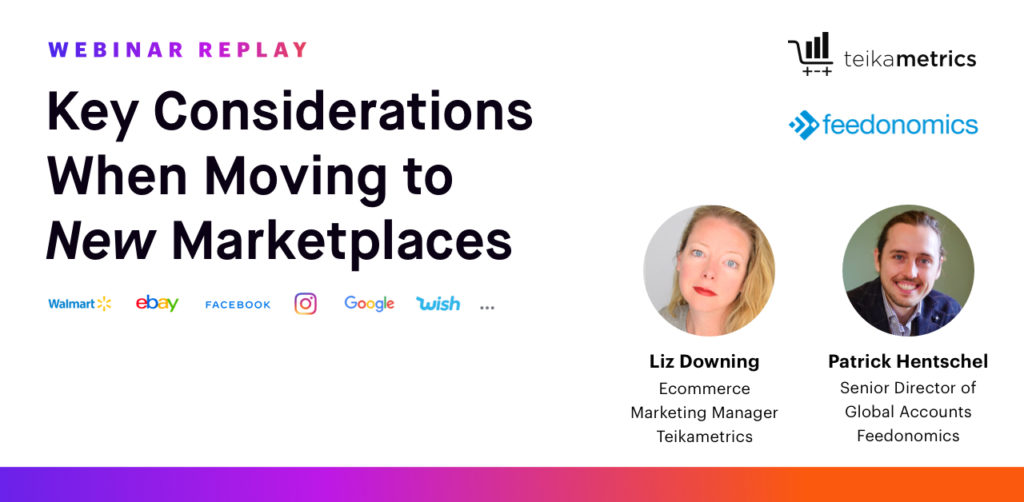Expanding to a new marketplace can be one of the quickest ways to grow your sales.
But before jumping to a new retailer you need to know whether it is the next best place to sell your products. And without a retailer-specific strategy, you’ll see stunted results and may wind up with more headaches than when you started.
In this webinar, Feedonomics joins Teikametrics for an in-depth conversation on how sellers should evaluate new marketplaces in the context of their own business, current best practices when listing your products on the new retail sites, and keys to sustainably scaling your business simultaneously across all the places you sell online.
Webinar Topics
- Criteria you should use when choosing the next marketplace to list your products
- Common missteps to avoid when getting your listings live
- How different marketplaces vary when it comes to effectively scaling using advertising
- Processes you should consider to stay ahead of the pack as you grow across multiple marketplaces
Show Links
- Connect with Liz Downing, Ecommerce Marketing Manager, Teikametrics
- Connect with Patrick Hentschel, Senior Director of Global Accounts, Feedonomics
- Check out webinars on marketplaces opportunities: Target, eBay, Walmart
Watch The New Marketplaces Webinar Replay
Webinar Highlights
Ask the right questions before expanding
Liz reviewed important questions to consider when you’re choosing a marketplace to expand to, including questions about competition and about customers.
“The easiest thing to figure out is if your competitors are on that marketplace. That’s an easy search. You look for your competitors and odds are, if they’re there, they’ve got plenty of reviews, that means that there’s a demand for your product on that marketplace. So it’s probably worth investing.
Now, knowing if your customers are there is a different story. You can do a poll among your current customers. You can do some polls on social, but you can also access external data. Walmart is really good about publishing customer profiles and breakdowns to help people understand what types of consumers are searching on Walmart.com.” – Liz Downing
Every marketplace has its own system for organizing product data
According to Patrick, there can be tens of thousands of categories for products on a single marketplace, but that varies from one marketplace to the next.
“Every marketplace typically has their own set of criteria that they want merchants to adhere to when sending them data. Depending on the marketplace, they might have 20,000 different categories that any product could potentially fit into.
Some marketplaces have fewer category options to choose from, some marketplaces have a string length of a hundred and others have a string length of something closer to 50 or 60.
And so all of these little details add up and they have a bearing on what kind of data you want to ultimately send to that marketplace if you’re looking to succeed there.” – Patrick Hentschel
Optimize your product data to fit each marketplace
It doesn’t matter whether you’re using an app or an API connection to upload your product data, Patrick explained, because if you’re not analyzing your product data and putting your best foot forward based on the algorithms on each marketplace.
“What we typically see is in all of these scenarios, there’s very little attention paid to how the data’s actually going to be crafted to present on the marketplace. And so you’re going to be at a competitive disadvantage.
If you’re the one who actually has control over the way that the listings present, let’s say you’re the registered brand on Amazon, then the way you optimize your data matters a lot. The way you name your products, the way you compose your descriptions, that’s going to be the dominant data that Amazon’s referencing when they potentially show listings against a search.
So, especially if you’re the registered brand, it becomes crucially important to make sure that your data is optimized, that you have brand in your title, that you have all of the proper nouns that people are likely to search with when they’re looking for the products that you’re selling.” -Patrick Hentschel
Keep product and order data synchronized across marketplaces
Patrick says that keeping data synchronized across marketplaces is crucial to avoiding stocking out and potentially getting suspended.
“Let’s say you’ve got a hundred products in stock, right? Let’s say BigCommerce is your ecommerce platform. So you’ve listed a hundred there and now there are a hundred products available out on Amazon and Walmart.
And you sell 70 products on them. Now you really only have three 30 products left available in stock, but what if within the next hour you sell 70 products on Walmart?
Now you’re in trouble because you’ve oversold your stock. You’re stocking out. And that’s a problem. It’s a big problem with marketplaces because if that happens once and then potentially if it happens more than once, it’s very easy to get suspended and it’s very difficult to get back on that marketplace. It can be very time-consuming.
So it’s crucially important that you have the ability to have your orders flow from these marketplaces into a system where you can easily fulfill those orders. And what’s also important along the way, as that happens is the inventory gets decremented within your ecommerce instance. So that the next time we push to Walmart and Amazon in this example all of your inventory counts are up to date. So it limits overselling.” -Patrick Hentschel
Go beyond listing requirements
Liz says a listing that’s filled out with the bare minimum to meet a marketplace’s requirements isn’t going to be a competitive listing.
“This is something I see a lot with people who sell on Amazon is that they’ll do the bare bones, product description, bullet points, do the bare bones amount of product photos.
And that’s just not quite enough these days to beat your competitors and to really win on any given marketplace…
It’s best to just start off on a marketplace with an exemplary listing because that also informs how successful your advertising is. If you don’t have the right keywords in your product description and the different parts of your listing, then you can’t advertise on those keywords and you’re dead in the water.
Go above and beyond and spend the time to make an excellent listing on any marketplace that you’re selling on.” – Liz Downing
Pick your marketplaces carefully
Patrick says it’s better to pick one or two marketplaces to start with than to try to expand onto multiple marketplaces all at once.
“Stay focused. A lot of times we’ll get people coming to us and they’ll say, okay, I want to be on these 15 marketplaces. Can you make that happen?
And they want us to just snap our fingers and suddenly they’re on all these marketplaces. Obviously, it’s true that we are omnichannel and so we can facilitate distribution to different marketplaces. So in principle, we could do that, but it’s not generally the best strategy because if you just get your listings on there and then you’re on 15 different marketplaces, it’s not going to be where you succeed.
First of all, a smaller number of marketplaces control most of the market share… But also if your focus is just that diluted, you’re not going to succeed in any one venue. So definitely I would say start with one or two at most, and then add on iteratively.” -Patrick Hentschel
Download Free Checklists For Moving To New Marketplaces
Liz and Patrick covered questions to ask yourself when evaluating new marketplaces to find the fit that will give your business the best opportunities, what you need to do to get all your business systems in order, and common pitfalls to watch out for. Now you can download free a handy set of checklists to be sure you don’t miss any of these questions as you prepare to expand onto new marketplaces.




